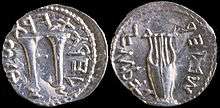Zuz (Jewish coin)
A Zuz (Hebrew-זוז; plural zuzzim Hebrew-זוזים) was an ancient Jewish silver coin struck during the Bar Kochba revolt, as well as a Jewish name for the various types of non-Jewish small silver coinage, used before and after the period of the revolt.[1] The name was used from the Greek era of drachmas, through the Roman era of Denarius, and then as the quarter denomination of Bar Kochba coinage. The Jewish insurrectionists' zuz were overstruck on Roman Imperial denarii or Roman provincial drachmas of Vespasian, Titus, Domitian, Trajan and Hadrian. Four Zuz, denarii or drachmas make a Shekel, a Sela or a Tetradrachm.
It has been suggested that its name is probably a corruption of the Greek Zeus which was the deity portrayed on the reverse of every drachm and tetradrachm (four drachma) of the Seleucid period. Another suggestion is that in Hebrew, the word "zuz" means "move", or "to move", so it was called "zuzzim" to show that it was constantly moving around, usually referring to the fact that Jews must give charity, or referring to the nature of money that it moves from one to another,[2] alternating who is wealthy. It has also been suggested that zuz is related to a root (not occurring in the Hebrew Bible) meaning "shining" or "glittering".[3]
According to Stephen Kaufman, however, zūzu is of Akkadian origin.[4] American Heritage Dictionary also states: “from Akkadian zūze, half, division, unit of weight, from zâzu, to divide”.[5]
In the Talmud, the Zuz and the dinar are used interchangeably, the difference being that the Zuz originally referred to the Greek Drachma (which was a quarter of the Greek Tetradrachm weighing approximately 17 grams) while the Dinar referred to the later Roman Denarius (which was a quarter of the Tyrian shekels and had the same weight as the Jerusalem Shekels and the Roman provincial Tetradrachms at approximately 14 grams).
The Zuz is mentioned in the Passover Haggadah in the Passover song Chad gadya, chad gadya (One little goat, one little goat); in which the lyric of dizabin abba bitrei zuzei (Which Father bought for two zuzim (half shekel) repeats at the end of every stanza. It may be significant that two zuzim equal the half-shekel tax required of every adult male Israelite in Exodus 30:13.[6]
See also
- List of historical currencies
- First Jewish Revolt coinage
- Bar Kochba Revolt coinage
- Shekel
- ma'ah
- Prutah
References
- ↑ Instone-Brewer, David. 2007. Traditions of the Rabbis from the Era of the New Testament. P.201
- ↑ "Bamidbar Rabbah (22:8)".
- ↑ Marcus Jastrow, A Dictionary of the Targumim. the Talmud, and the Midrashic Literature (1903, 2nd ed. 1926, NY) page 385, s.v. זוז (II); Alexander Harkavy, Students' Hebrew and Chaldee Dictionary to the Old Testament (1914, NY, Hebrew Publ'g Co,) page 134, s.v. זו.
- ↑ Kaufman, Stephen (1974). "The Akkadian Influences on Aramaic". Assyriological Studies. The Oriental Institute of the University of Chicago. 19: 114. Retrieved August 20, 2013.
- ↑ "zuz - Dictionary definition and pronunciation - Yahoo! Education". Retrieved August 20, 2013.
- ↑ The Targum Jonathan, the Aramaic paraphrase of First Samuel 9:8, translates the "quarter-shekel" in the original Hebrew into "zuz", making one zuz equal to one-fourth of a Temple shekel (not a "common shekel"- of which a zuz represented one-half, according to some Talmudic mentions), and two zuzim equal to half of a Temple shekel.
